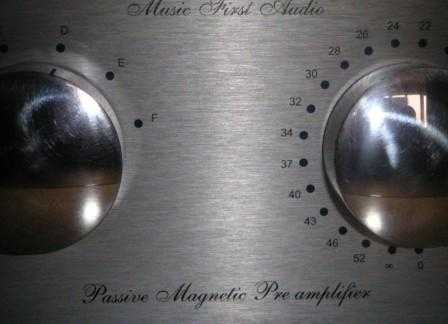

Product: Music First (TVC) Passive Magnetic Pre Amplifier
Manufacturer: Stevens and Billington - England
Price: Copper Version £1600 GBP
Price: Silver Version £2750 GBP
Reviewer: Paul Eros - TNT UK
Reviewed: October 2007
Back when Mrs Thatcher was Prime Minister of these British Isles a certain Scotsman was promulgating the idea of "source first". The idea went that the front end of the system was the most important element of the replay chain because garbage in meant garbage out (GIGO). This went on to support the marketing hype of source first and the mantra that you should spend at least two thirds of your system budget on the best front end you could buy.
Whilst I'm not going to argue with the GIGO principle I will point out that any hi-fi system is as strong as its weakest link. So the precious signal from your record player, CD player, Super Audio CD or DVD can become strangled and corrupted by the components further down the chain.
The front end of the system may be the driving force but the amplifier is its soul. It should add nothing, nor take anything away from the signal, its only job is providing gain and switching between sources. Unfortunately too many pre amplifier designs fail in this basic undertaking, adding euphonic bloom or sounding cold and sterile. Whilst electrical engineers strive for neutrality in their amplifier designs achieving it isn't as easy as one might think. We've all heard amplifiers that present music with the constituent parts laid bare but with all the emotion and soul ripped from the performance. Real neutrality is a balancing act between revealing the inner workings of music and presenting the coherent performance originally created by the musician. Its also the reef upon which many amplifier designs have floundered.
The Music First TVC (transformer volume control) passive magnetic pre amplifier is one of those very rare components that provide an "open window" to a musical performance without shredding the performance into a sterile procession of notes. When I first heard it I had to have one and paired it with a Bel Canto eOne s300 power amplifier. Feeding ART Stilleto speakers, in a smallish listening room, I am treated to performances of exceptional quality.
My MF pre amp uses high purity, silver coated, copper wires , however, on a recent visit to the Stevens and Billington factory I became aware that a more expensive, all silver wired version was available. I was curious to find out how this more exotic version would perform and whether it would be able to justify an increased price versus the copper version (£2750 for silver; £1600 for copper).
For those unfamiliar with the MF copper wired pre amp the next few paragraphs will serve to acquaint you with this widely acclaimed product.
The Music First pre amplifier is a passive pre amp. The concept of passive control units is not a new one and has been practiced by a number of companies for some time. It is also a favorite of DIY enthusiasts. They offer a relatively simple method of attenuating the signal from the source component before passing it to a power amplifier. They have minimal component count and short signal paths.
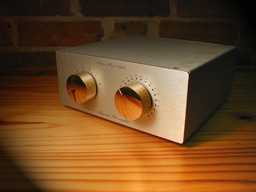
Above: Official Web Photograph of the copper wired amp. Mine has silver knobs
To date, however, conventional passive pre amplifiers have relied upon resistive networks selected with a switch or rotary variable resistors and herein lies the problem with conventional passive pre amplifiers. The resistive volume control presents fundamental issues of impedance mismatching both at source or the load and in worst cases, a perceived loss of dynamics. This dynamic "compression" robs music of much of its subtle nuance and can make for a fatiguing and ultimately uninvolved listening experience.
The Music First pre amp gets over these issues by using high quality, custom made, hand wound transformers housed in a Mu-metal shielding can. It is a substantial device measuring 60.25mm (diameter) x 72mm (height). Each pre amplifier makes use of a pair of these devices (one for right channel and one for left channel). Stevens and Billington (the designers and manufacturers of the MF pre amplifier) claim that the transformer features the largest commercially available 80% nickel Permalloy core which delivers maximum level handling, low distortion and superior sound quality. Those of you wishing to read more of the technical detail behind the transformers found in the MF pre amp should follow the link to www.mfaudio.co.uk/datasheet1.htm. The upshot of all this science is that the transformer volume controlled preamplifier suffers no impedance mismatching of source or load and none of the issues of dynamic compression found in resistive network pre amplifiers.
The sound is clean, neutral and very dynamic. It is also a very fast sounding amplifier; although this will also be determined by the choice of partnering power amp. BUT and it's a big but for a reason, this is not one of those amps that has you turning your system off after a couple of tracks of lightning fast, leading edge helter skelter. It is a very refined performer and can appear almost valve like (without the warm rosy euphony) in its presentation. Indeed this may well be the perfect cross over product. Offering the best of both transistor and tube designs in a small silver and very environmentally friendly box (it uses no power of its own and doesn't have the thermal output of a medium sized radiator)).
The component count is sparse with the two transformers being augmented by two very high quality Swiss made ELMA switches, Neutrik XLR connectors, RCA sockets, a couple of toggle switches and point to point wiring. All were decided upon for reasons of sonic performance. The amplifier can be used with either balanced or unbalanced sources. It can also output to a power amplifier through balanced or unbalanced connections. This provides for quiet a neat trick as you are able to run the pre amp fully balanced (in puts and outputs) or in mixed configuration, with the choice being yours as to how your equipment sounds best.
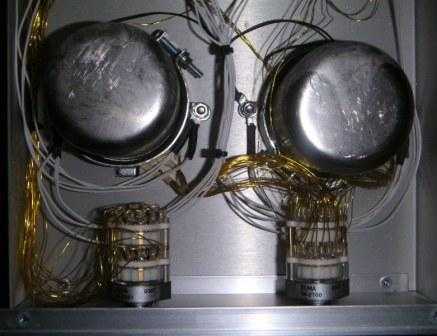
Above: High quality components and point-point wiring throughout
This is also no hair shirt hi-end product either as it has six inputs (2 balanced and 4 RCA connections), though there are no tape or record loops. However, Stevens and Billington have added these to custom orders and their latest development, soon to be released, will offer this functionality for those who want it.
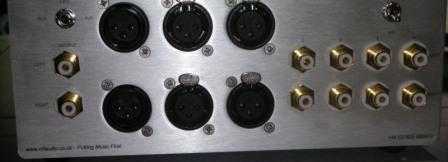
Above:The rear panel of the MF amp with single-ended and balanced connections
The unit also has a +6db switch which means that the unit is passive with gain, thereby, according to the manufacturer, allowing low gain amplifiers to be driven to their maximum efficiency by components that otherwise might require active boosting
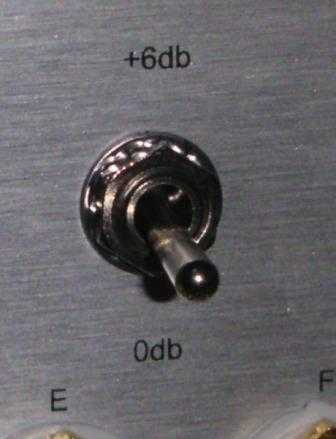
Whilst the standard version of the MF pre amp makes use of high purity copper wire in the transformer windings and silver plated copper wire for connections, the Silver Version uses pure silver wire in the transformer windings and for all point to point wiring. All socketry is silver plated and silver solder is also used for connections.
From the front panel there is no way of telling the two versions apart and the box used for both amplifiers is also identical. Around the back, however, the silver version stands out by virtue of its silver plated socketry. Internally the layout of the two amplifiers is identical but the silver version uses different coloured PTFE insulation.
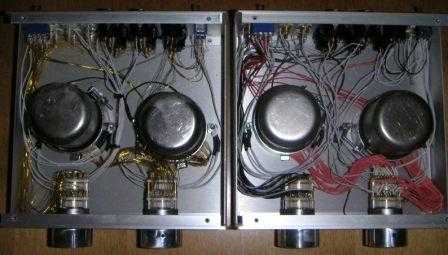
Above: Silver version (left) and copper version side by side
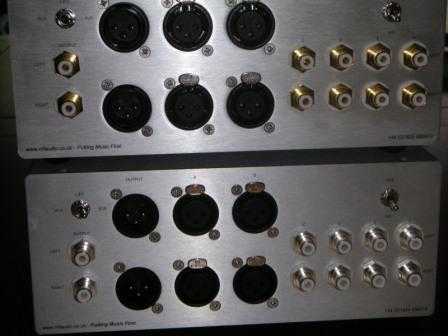
Above: Rear panel view with silver version (bottom) sporting silver socketry
I don't know what I was expecting when I started this review. Like everyone I have experienced the difference all silver wire can make in a system ....and it's not always positive. Often the increased drive and energy you get is accompanied by an unwanted harshness and a stark, almost brittle quality to the sound. It was with these past experiences in mind therefore, that I approached the review with some caution. Would silver wires upset the natural balance and neutrality of my chosen reference pre amplifier? Time to find out!
Shirley Brown's "Woman to Woman" is one of my favorite albums from the Stax label. This woman is a phenomenon. Born in West Memphis, Arkansas on 6th January, 1947, Shirley never enjoyed quiet the same high profile and fame as some of her contempories. That is a crying shame because this lady has an innate feeling for the lyrics that enables songs to come alive and impress themselves upon the listeners' mind and memory.
This album showcases vinyl at it's best and the opening track of side II - "Woman to Woman" - shows off the soaring vocals of Shirley and the skills of the session musicians, to outstanding effect. I've always loved this track and know it well. With the silver wired MF in place the plucked guitar at the start of the track gave the impression of being closer to the listener. There was more energy to the strings. Not the type that fizzes with distortion but the type that makes a recorded instrument sound just a little more realistic. But the biggest impact came when Shirley started to sing. The sense of a real person in my room, standing large between the speakers, was uncanny. Vocals took on more clarity and were easier to follow. There was also a further resolving of emotion and the subtle inflexions of her voice that let you know she is singing about her own experiences.
The soundstage also took on more height, depth and breadth perspective. Whilst Shirley remained centre stage the backing vocalists were placed clearly to one side and behind her. More startling was the sense that the backing vocalists seemed to be standing in a line as opposed to being grouped together.
Elsewhere the chemistry between the session musicians is easy to comprehend and each instrument is easy to pick out and follow without the mix falling apart. I could hear the bass line progressing up and down the scale. The horn section could be heard in the background, very clear and distinct. Each instrument and performer seemed to have more space around them in which they could "breathe", yet each was assembled into a musically coherent whole.
Switching back to my own copper pre amp I had a sense of the same easy rhythmic flow achieved by the silver wired version. The plucked strings at the start of the track were still detailed but were marginally less intense and some of that energy from the plucked string was lost. The sound stage also sounded more "compressed" and "congealed".Please do not misunderstand this last point. The copper wired pre amp is still finely detailed and presents a big open soundstage with excellent neutrality. It is just marginally less transparent to the micro dynamic details in the music.
Bass notes still progress up and down the scale just less sinuously. Instruments appear further back in the mix and note changes are less distinct. Those backing vocalists now appear to be standing in a group and are arranged around Shirley who is not now illuminated by her own spotlight. The copper version presents a wonderful performance it just seems marginally less real and involving.
During my time with the silver wired pre amp I listened to albums on both vinyl and CD. From U2 to Leonard Cohen and Beethoven, the silver wired version had marginally more to offer than my copper wired amp. My wife summed it up when she said that the silver version sounded less "grainy".Whilst the copper amp is certainly free of "grain" I do know what she means. With the silver wired amp in place my system seemed to have more air, space and clarity. Detail retrieval was exceptional and there was no loss of musicality or coherence. In fact if anything the performance seemed to be more together.
I am very impressed by both of these pre amps. Either represents a very worthwhile step towards hi-fidelity musical reproduction in the home. That the silver version offers performance improvements over the copper version is clear. Perhaps less clear is whether you consider these benefits to be worth the extra cost.From my perspective I thoroughly enjoyed my time with the silver wired amp. It is superior to the copper version in many respects but those silver wires come at a cost and herein lies my dilemma. Is the performance increase worth an additional £1000 for those silver wires? Ultimately I decided that it wasn't and will be sticking with my copper wired version.
If however, you own a more esoteric system than mine, or want to prise the very last ounce of performance from your set up, then you must evaluate the silver amp in your system. At the end of the day you pay your money and make your choice.
A factory tour of Music First Audio can be found here.
© Copyright 2007 Paul Eros - www.tnt-audio.com